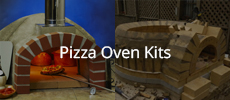Announcement
Collapse
No announcement yet.
2024 Neapolitan oven build
Collapse
X
-
Ok. It is a technique which gives greater stability and control, used for bracing kilns where the expansion issues are around double what we experience with our ovens, but the same principles apply. For kilns the rods and nuts are usually exposed which allows access for adjustments before, during and after firings.
-
I’m not to worried about it, as the tension of the reinforcing straps will be pulling he upright brackets outwards, while the threaded rod across the top will secure them from moving outwardly. The other thing is, on the threaded rod, I plan to put double nuts on the inside and outside of the angle to lock the angles at 90 degrees.Originally posted by david s View Post
The Brackets are 50x50x5mm steel angle, professionally welded in a precision engineering factory, which will make them really rigid and resistant to twisting once they are anchored with 10mm stainless concrete anchors.
Leave a comment:
-
Thanks, I guess I’ll look at it when I’m there and make a decision then. Really depends on how big the keystone will need to be as to what I will choose to do.Originally posted by nlinva View PostThere are definitely examples of people mortaring bricks together to serve as keystone.
A vertical mortar joint can be seen, for example, in Giovanni Rossi's build (post 54 here).
Other people have also done horizontal mortar joints, which is what I'm about to try doing. Two of my bricks stacked flat on top of each other are only about 1/4" taller than the width of the brick, so the keystone will stick out above the rest of the dome by about that amount, which I'm fine with. It does give you the full flat area of a brick to serve as the keystone, which I like. If I decide that 1/4" bothers me, I may just grind a bit off the top with my angle grinder before dropping it in.
Right now I'm thinking about how best to mark and measure the shape of the opening so I can transfer it to the bricks. It is not so hard to transfer the bottom shape to the bottom of the keystone, but the challenge is to mark off the top so that not only is the orientation the same, but also the centerpoints line up. Are there tried-and-true tricks for this?
With some of my more tricky cuts where I felt it was really important to have it fitting well, I made templates from cardboard. Easy to cut with scissors, and easy to start fresh if I cut too much off. Worked well for me.Last edited by daidensacha; 09-10-2024, 10:09 PM.
Leave a comment:
-
There are definitely examples of people mortaring bricks together to serve as keystone.
A vertical mortar joint can be seen, for example, in Giovanni Rossi's build (post 54 here).
Other people have also done horizontal mortar joints, which is what I'm about to try doing. Two of my bricks stacked flat on top of each other are only about 1/4" taller than the width of the brick, so the keystone will stick out above the rest of the dome by about that amount, which I'm fine with. It does give you the full flat area of a brick to serve as the keystone, which I like. If I decide that 1/4" bothers me, I may just grind a bit off the top with my angle grinder before dropping it in.
Right now I'm thinking about how best to mark and measure the shape of the opening so I can transfer it to the bricks. It is not so hard to transfer the bottom shape to the bottom of the keystone, but the challenge is to mark off the top so that not only is the orientation the same, but also the centerpoints line up. Are there tried-and-true tricks for this?
Leave a comment:
-
-
Keystone question
If my calculations are correct, I will have a hole with a diameter 120-140mm to fill with a keystone to finish my dome. I have my last three courses to do now before fitting the keystone.
I guess there would be many ways to do it, using multiple stones count to fit. It is feasible to cement two bricks together from which I can cut one piece to fill the hole?
Leave a comment:
-
Yes, I’m using all stainless steel, apart from the brackets which are steel, and will be galvanised. Brackets will be ready next week, hopefully I will have set the keystone in the dome by then and I’ll fix the brackets. Measure the required length for the stainless straps and have them welded to the tightening brackets which I’ll then be able to attach to the galvanised brackets.Originally posted by david s View PostYour anchors will be in a place that will be subjected to both heat and moisture, both of which accelerate rusting, be sure to use stainless anchors. Otherwise their failure in a position that’s not accessible easily, could negate the function of the stainless band.
Leave a comment:
-
Your anchors will be in a place that will be subjected to both heat and moisture, both of which accelerate rusting, be sure to use stainless anchors. Otherwise their failure in a position that’s not accessible easily, could negate the function of the stainless band.
Leave a comment:
-
Reinforcing brackets being fabricated. Rainy weather slowing progress.
I thought it would get easier, but I kind of gave up on that notion, as with each obstacle sorted comes another. Now I’m just tackling each obstacle as they come and evolve. I did another course yesterday, the first that I couldn’t complete from inside the oven. That required developing a different skill set to lay standing on the outside of the dome. By the end of the course I got used to it.
I have 5 more courses to complete the dome now. The angles of the cuts are becoming a little more to think about. My next course is the first where I think I will reduce the size to 1/3 bricks to reduce the horizontal triable gap that is beginning to develop between the bricks.
I was at an Engineering factory of a friend yesterday, and he is welding up some brackets I designed to fix my stainless support straps around the oven. Should be ready in a week, galvanised to limit rust.
I made up a template out of wood just as an example, and I think it will work well. Each will fixed to the slab with two anchor bolts, and together with a threaded rod across the top of the arch. From this I made up my plans in sketchup. 50x50x5mm steel angle, galvanised.
The weather lotto here in Bavaria where I live isn’t good this week, cloudy with forecast rain. Yesterday I was lucky, today not. Ideally I would be happy if I have enough windows without rain this week to finish the dome so I can fix my stainless steel reinforcing straps around the oven, and get onto building up the vent. I need to complete this so I can start getting the insulation on the oven.
Leave a comment:
-
As expected: impeccable masonry! It's looking really great and you're also making great progress. Like you I'm hoping the weather lotto will give us some more working days towards the wet and cold season....Originally posted by daidensacha View PostInner dome brickwork.
Integrating the dome bricks with the arch was messy, and dusty. I cut the inside of the top of the arch to allow for easier nesting of the dome bricks.
I cleaned up the dregs today, set my IT for the new course, and took my measurements for the radius, and angle to make cuts tomorrow, weather permitting.
I also went around the inner joins of the bricks, repointing voids between where the bricks meet. It will not get easier as I progress up the dome, so want to keep it as good as possible while I have easy access.
Leave a comment:
-
The second pic was after the final render coats. Your plan to do some small test batches is a good one. The grain sizes you posted for the vermiculite and the perlite are what I use.
- Likes 1
Leave a comment:
-
david s Thanks David.
My designed base allowed for 100mm ceramic fibre blanket, covered by 150mm vermicrete. At the sides I will need to add that so the sides of the dome meet the sides of the base, but I can go thinner on top with the vermicrete. If I got you correctly, I’ll plan on adding 4 x 35mm layers of vermicrete at a time, a week apart to allow each layer to dry sufficiently before adding the next. Our fist frost is possible from mid October, but we can still have warm days. Weather lotto, will just have to be flexible.
I think I’ll knock up a small test batch of a few liters of homebrew to test it and get the hang of mixing it. The sizes of the vermiculite and perlite is hopefully going to work, as I mentioned some time ago, i had issues translating fine and medium into German measurement standards. Maybe I could break my vermiculite down a bit if its not fine enough.- 5 parts vermiculite (2-3mm)
- 5 parts perlite (2-6mm)
- 1 part portland cement powder
- 4 parts water (added 1/3 at a time and hand mixed in bucket or barrow)
- 1 handful of clay powder per litre of cement added
One question about the photos you posted showing the vermicrete being added directly over the blanket. The second shows a really smooth finish, is that only vermicrete, without render? If I can get something close to that finish I’ll be really happy.
Leave a comment:
-
The P/vcrete layers are about 2-3" thick by 4-5" tall over 3" of ceramic blanket. I did not use any clay but I know David S advocated using some for work-ability.
Leave a comment:
-
150mm thick vermicrete layer is very thick. I’ve found if you want a thick layer it is better not to go any thicker than around 35 mm. This takes around a week to dry in ideal conditions, any thicker and the moisture deeper in just doesn’t escape. If you want it thicker then do a second layer after the first one has dried. Excessive insulation is subject to the law of diminished returns. As well as insulating the v’crete evens out the lumps and bumps of the blanket as well as providing a firm substrate onto which you can apply the outer rendered layer, once it’s all dry and the drying fires have been completed.
This pic shows the vermicrete layer being applied over the blanket. Because it is a corner build (I hate corner builds) there was very little room at the sides. Two layers of blanket there but four on top. I also never bother with chicken wire over the blanket. I believe it's a waste of time, it compresses the blanket, reducing its insulation value. The vermicrete will restore the perfect shape you want.
Last edited by david s; 09-08-2024, 02:40 PM.
Leave a comment:





Leave a comment: